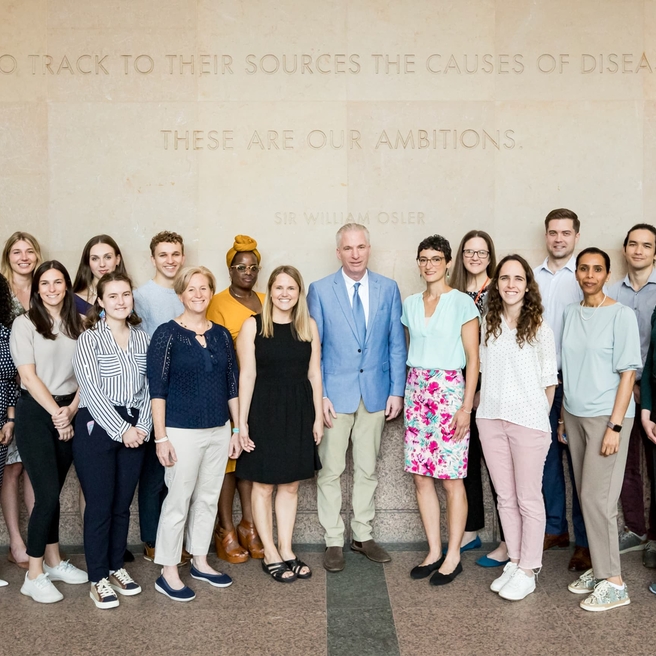What is Skraban-Deardorff syndrome?
Skraban-Deardorff syndrome, also known as WDR26-related intellectual disability, is a rare genetic disorder. It is characterized by developmental delay, intellectual disability, seizures, neurological symptoms, and subtle facial differences.
The syndrome was first described in 2017 by identifying 15 unrelated individuals who have mutations in a particular gene and finding that all share a similar cluster of symptoms. Since that time, many additional patients have been diagnosed with the condition.
Causes
Skraban-Deardorff syndrome is caused by mutations in the WDR26 gene.
In the individuals identified to date, the vast majority are de novo mutations. This means that the mutations are not inherited from either parent, but instead are random mutations that occur during early development.
The mutations are also heterozygous, which means that only one copy of an individual’s pair of the WDR26 gene has the mutation.
Signs and symptoms
The symptoms of Skraban-Deardorff syndrome vary among individuals. Not every person with the syndrome exhibits all of the symptoms or exhibits them in the same way. Symptoms include:
Developmental delay and intellectual disability
- People with Skraban-Deardorff syndrome have varying degrees of developmental delays and intellectual disabilities, ranging from mild to severe.
- Speech delays are typical, particularly expressive speech delay. This tends to be the developmental difference that kids struggle with the most.
- Delays in the development of motor skills are typical including sitting and walking. Many walk with a wide-based, spastic, stiff-legged gait.
- In terms of behavior, some people with the syndrome have stereotypical movements and autistic features. Some have a formal diagnosis of autism spectrum disorder. Most are described as being happy and socially engaging.
Neurological differences
- All individuals in the initial sample group had a history of seizures. With time, we have identified many individuals who don’t have seizures, but they remain common. Some of the seizures had been triggered by fever (febrile seizures); others had not. Some had received treatment with antiepileptic medications, which typically brought the seizures under control.
- Minor structural brain malformations have been identified in some people.
- Decreased muscle tone (hypotonia) is common.
Facial differences
- People with Skraban-Deardorff syndrome typically share a set of subtle facial characteristics, though not every individual with the syndrome exhibits all of them. These characteristics include:
- prominent upper lip and upper jawbone
- wide mouth
- abnormal gums
- widely spaced teeth
- mildly coarse facial features
- broad nasal tip
Other health differences
- People with Skraban-Deardorff syndrome can have a variety of other health issues. Some more common seen health issues include:
- Feeding issues/poor growth
- Ophthalmologic differences
- Structural heart differences
- Skeletal differences
- Cleft palate
- Genitourinary differences
- Recurrent infections
- Sleep issues
Testing and diagnosis
If symptoms suggest Skraban-Deardorff syndrome, diagnosis is typically made with whole exome sequencing, a genetic test that looks at the sequencing of the more than 20,000 protein-coding genes in the individual’s DNA.
Because Skraban-Deardorff syndrome has been typically found to be caused by de novo (spontaneous rather than inherited) mutations in the WDR26 gene, it is useful to confirm that neither parent carries the variant.
Treatment
Currently, there is no specific treatment for Skraban-Deardorff syndrome. Care focuses on the individual’s symptoms. The medical team typically includes a genetic specialist, a neurologist and a developmental pediatrician, with other specialists involved as symptoms warrant. Early therapy is encouraged (physical, occupational, speech therapy) to ensure that the child achieves to the best of their abilities. Applied Behavior Analysis (ABA) therapy has been beneficial for some individuals.
Clinical trials may also be an option. Your doctor can help you learn more about these studies. You can also find a list of ongoing studies at www.clinicaltrials.gov.
Outlook
Because Skraban-Deardorff syndrome has only recently been identified, the long-term outlook for patients is not yet fully known.
In general, patients with developmental delays and intellectual disability benefit from support and therapy, which can improve the quality of a child’s life. Seizures can be treated with antiepileptic medications.
Follow-up care
Annual follow-up visits with an appropriate team of specialists are recommended for children with Skraban-Deardorff syndrome. Regular monitoring allows the medical team to adapt therapeutic treatment to the child’s changing needs. The care is geared to providing the highest possible quality of life and addressing any symptoms that cause discomfort or put the child’s health at risk.
Why choose CHOP?
Skraban-Deardorff syndrome was discovered at Children's Hospital of Philadelphia (CHOP) and the experts at CHOP are leaders in research on the syndrome.
CHOP provides comprehensive clinical care; diagnostic testing; and state-of-the-art, multidisciplinary care to infants, children and adolescents living with genetic conditions like Skraban-Deardorff syndrome.
For parents of children with Skraban-Deardorff syndrome and other genetic conditions, CHOP provides training on special care needs, as well as genetic counseling to explain the risk of having another child with the condition.
Resources to help
Reviewed by Cara M. Skraban, MD
